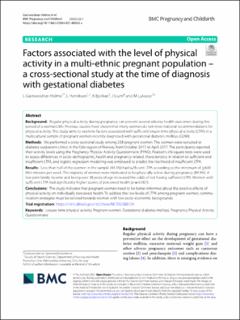| dc.contributor.author | Garnweidner-Holme, Lisa | |
| dc.contributor.author | Henriksen, Lena | |
| dc.contributor.author | Bjerkan, Kirsti | |
| dc.contributor.author | Lium, June Siren | |
| dc.contributor.author | Lukasse, Mirjam | |
| dc.date.accessioned | 2022-11-01T14:53:24Z | |
| dc.date.available | 2022-11-01T14:53:24Z | |
| dc.date.created | 2022-01-22T13:15:08Z | |
| dc.date.issued | 2022-01-03 | |
| dc.identifier.issn | 1471-2393 | |
| dc.identifier.uri | https://hdl.handle.net/11250/3029404 | |
| dc.description.abstract | Background: Regular physical activity during pregnancy can prevent several adverse health outcomes during this period of a woman’s life. Previous studies have shown that many women do not meet national recommendations for physical activity. This study aims to examine factors associated with sufficient leisure-time physical activity (LTPA) in a multicultural sample of pregnant women recently diagnosed with gestational diabetes mellitus (GDM).
Methods: We performed a cross-sectional study among 238 pregnant women. The women were recruited at diabetes outpatient clinics in the Oslo region of Norway from October 2015 to April 2017. The participants reported their activity levels using the Pregnancy Physical Activity Questionnaire (PPAQ). Pearson’s chi-square tests were used to assess differences in socio-demographic, health and pregnancy-related characteristics in relation to sufficient and insufficient LTPA, and logistic regression modelling was employed to predict the likelihood of insufficient LTPA.
Results: Less than half of the women in the sample (44.5%) had sufficient LTPA according to the minimum of ≥600 Met minutes per week. The majority of women were motivated to be physically active during pregnancy (84.9%). A low joint family income and being over 38 years of age increased the odds of not having sufficient LTPA. Women with sufficient LTPA had significantly higher scores of perceived health (p = 0.007).
Conclusions: The study indicates that pregnant women need to be better informed about the positive effects of physical activity on individually perceived health. To address the low levels of LTPA among pregnant women, communication strategies must be tailored towards women with low socio-economic backgrounds. | en_US |
| dc.language.iso | eng | en_US |
| dc.publisher | BMC | en_US |
| dc.rights | Navngivelse 4.0 Internasjonal | * |
| dc.rights.uri | http://creativecommons.org/licenses/by/4.0/deed.no | * |
| dc.title | Factors associated with the level of physical activity in a multi‑ethnic pregnant population – a cross‑sectional study at the time of diagnosis with gestational diabetes | en_US |
| dc.type | Journal article | en_US |
| dc.type | Peer reviewed | en_US |
| dc.description.version | publishedVersion | en_US |
| dc.rights.holder | Copyright 2022 the authors | en_US |
| dc.source.articlenumber | 1 | en_US |
| cristin.ispublished | true | |
| cristin.fulltext | original | |
| cristin.qualitycode | 1 | |
| dc.identifier.doi | 10.1186/s12884-021-04335-x | |
| dc.identifier.cristin | 1987756 | |
| dc.source.journal | BMC Pregnancy and Childbirth | en_US |
| dc.identifier.citation | BMC Pregnancy and Childbirth. 2022, 22, 1. | en_US |
| dc.source.volume | 22 | en_US |

